8:00 a.m. It was raining as we met at Wild West Adventure Company headquarters in Greymouth for our Dragons Blackwater Cave Rafting trip. Our guide, Kevin, was a California native who works during the U.S. summer for Class IV rafting company in West Virginia. Of the seven paying members of the tour, six of us were Americans and one German. Having a small group was nice. They take up to 13 per tour. I'd been looking forward to tubing through a glow-worm cave since we first started planning our trip to New Zealand.
The first order of business was to read and sign the liability waiver. It warned us of the hazardous nature of our trip, then stated that the waiver was largely superfluous since if we got hurt, we wouldn't be able to sue anyway. New Zealand has a no-fault system concerning personal injury whereby the Accident Compensation Corporation covers medical care resulting from accidental injuries that occur while in New Zealand.
After the paperwork, we stripped down to our "bathing costumes" and squirmed into the gear provided by Wild West: A wool shirt, a full wetsuit, two pairs of wool socks, booties, gum-boots, and helmets with headlamps. Then we waddled outside and loaded into the back of a truck for a ten-minute ride out of town. The rain had died down at this point to a more moderate drizzle.
A 30-minute bush walk through the rainforest took us to Taniwha Cave. I could see why the gum-boots were needed. It's a muddy track. Kevin asked me to take the lead on the walk, and he brought up the rear. Kevin carried a waterproof camera and stopped us from time to time during the morning for photos, which, of course, would be available for purchase at the end of the trip.
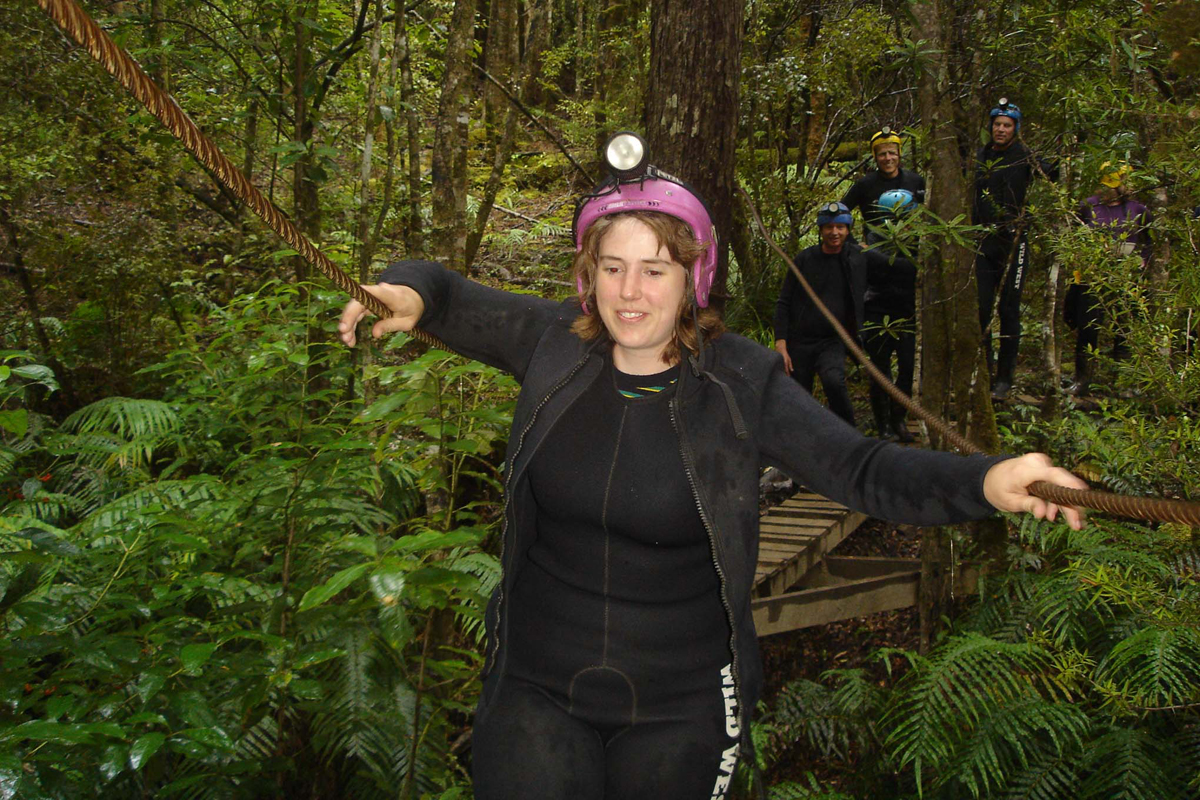
Hiking to Taniwha Cave
We climbed down into the cave following a stream, and soon Kevin offered us a choice. You could climb through the main passageway or, if you dared, belly crawl through a small side passage dubbed the "Love Tunnel." The Danger Girls (two adrenaline-charged gals from Las Vegas), Jorgen (our young German), and I took the side tunnel. It only took about ten minutes to wriggle through the passage, but it seemed like an hour and a half. It was SMALL, the most claustrophobic place I've ever been (not counting airplanes). I'm glad I did it, but I was relieved when it was over. I sprained my thumb moderately on the crawl, but I was confident I'd be able to hit the A and O keys on my steno machine by the time I returned to Knoxville.
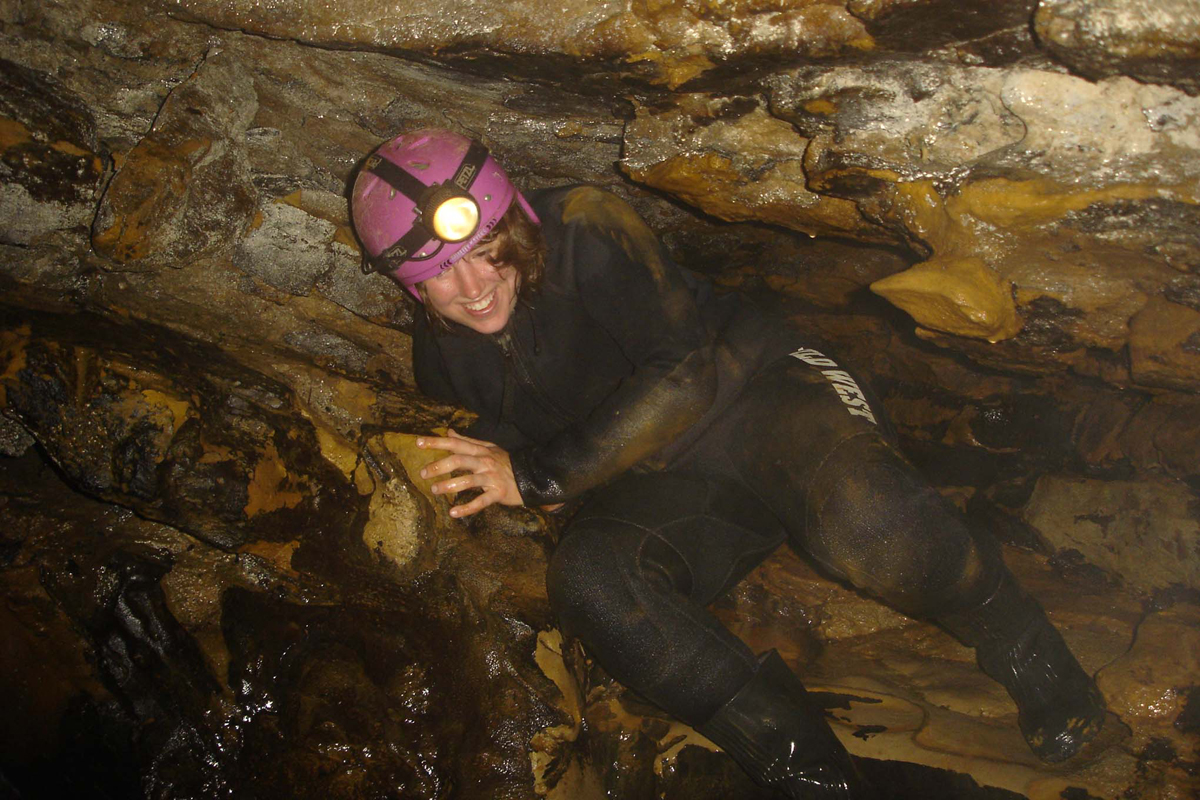
Jana emerges from the Love Tunnel
Except for Kevin's, our headlamps were all quite dim, and we quite literally felt our way further into the cave until we reached a small waterfall. You couldn't see the waterfall until it was your turn to slide down it. It was short, yes, but it was longer than I expected. When you hit the water below, you were completely submerged. Even with a wetsuit, the water is cold! It felt good on my poison ivy, though.
We slogged through a pool and came upon a pile of inner tubes. Each of us took a tube and turned off our headlamps as we floated down the passage beneath the glow worms. It was like drifting under a starry sky.
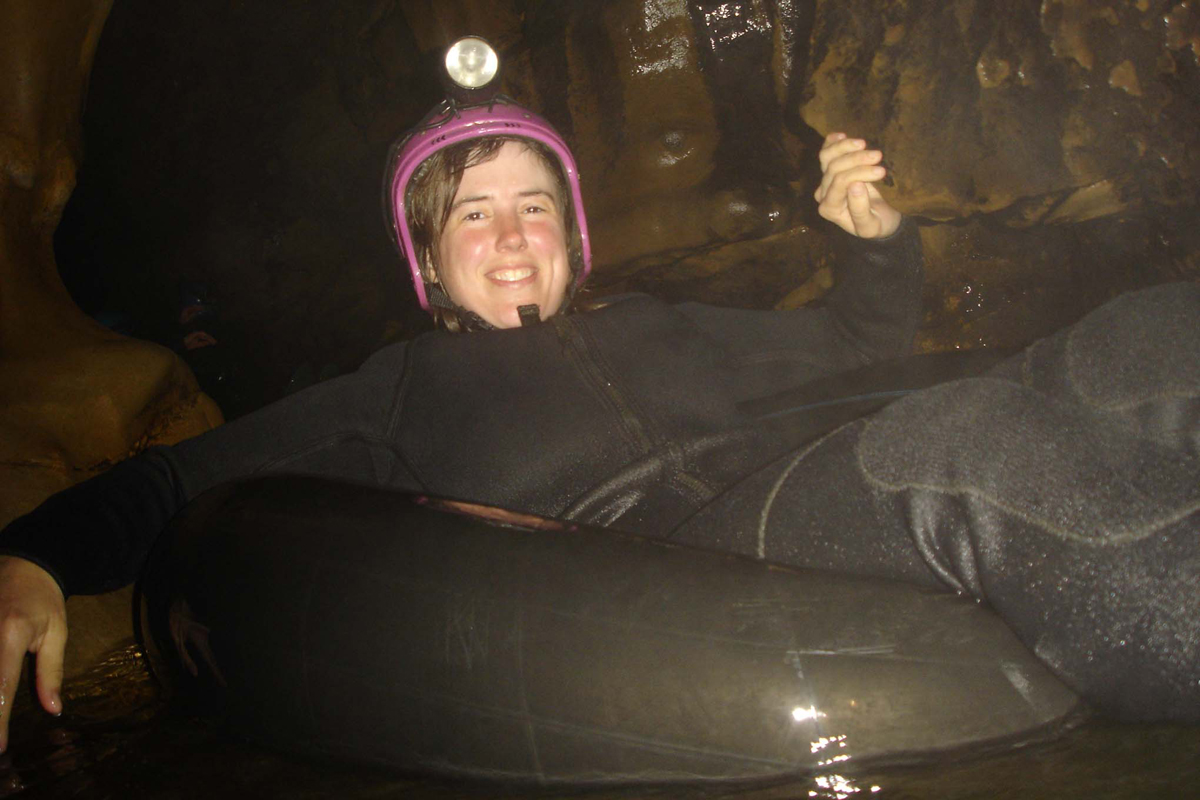
Cave tubing
After a relatively brief float, we stacked up our inner tubes and continued deeper into the cave. When we reached the normal turnaround point, Kevin offered to take us further than the groups usually go since we were moving so well. The next section was pretty steep, and we were all extra-careful to avoid stepping into hidden holes washed into the rock. Kevin said he'd never gone that far into the cave before, but he might have been kidding. The extra amount of caving was increasingly steep and strenuous.
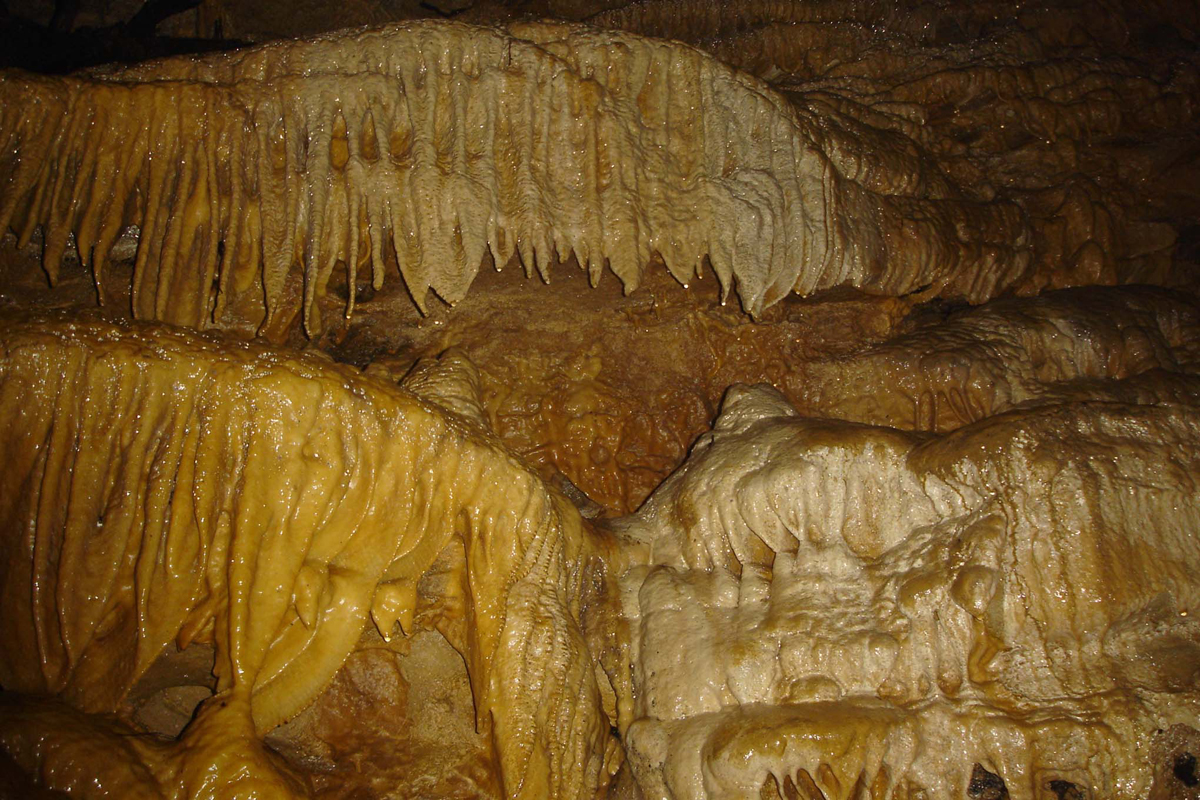
Fabulous flowstone
When we got back to the inner tubes, Kevin offered us some well-earned candy bars and hot chocolate from a thermos. Then we carried the tubes to a point a couple of feet above the water and jumped backwards with them into the stream - another excellent photo op for Kevin. We drug ourselves back upstream clinging to the rocky sides of the cave and restacked the tubes for the afternoon group.
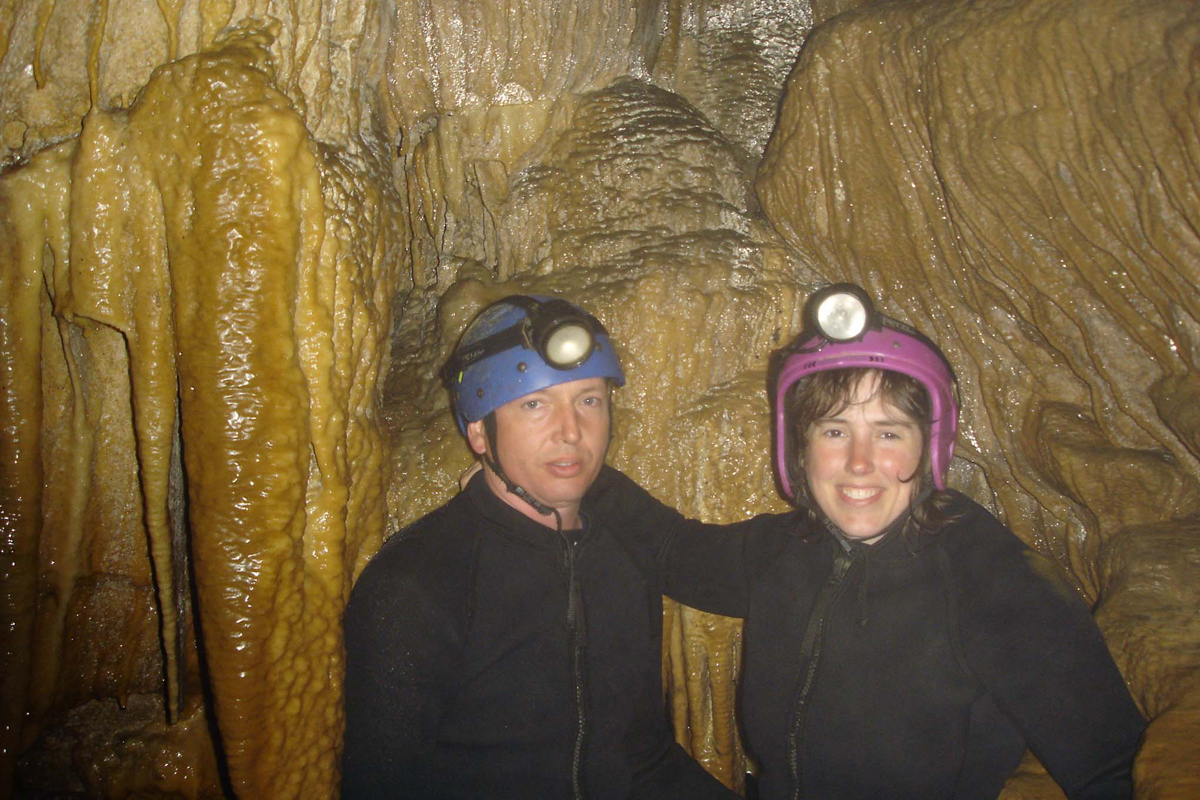
Caving rules!
Normally, the final narrow passage is done without the guide, who scurries back up the main cave passageway and awaits the group. I was asked to lead the way. It's a tight crawl through attractive flowstone tunnels and little pools of water. I entered the passage, then Tom. Tom immediately balked, turned around, and said he wasn't doing it. When he bailed, so did most of the others. No one would follow me. I had failed as a leader! I waited alone until Jorgen finally joined me. The others finally agreed to follow as long as Kevin would come along also, so he instructed me to go ahead and lead, he'd bring up the rear, and to wait for him at the end.
At the end of tunnel is the "Rebirthing Hole," a ridiculously small exit point. Kevin went through first and took a picture of each of us as we emerged, except for Tom, who couldn't wait for him to get the camera out and quickly followed Kevin out and headed for the light at the end of the tunnel.
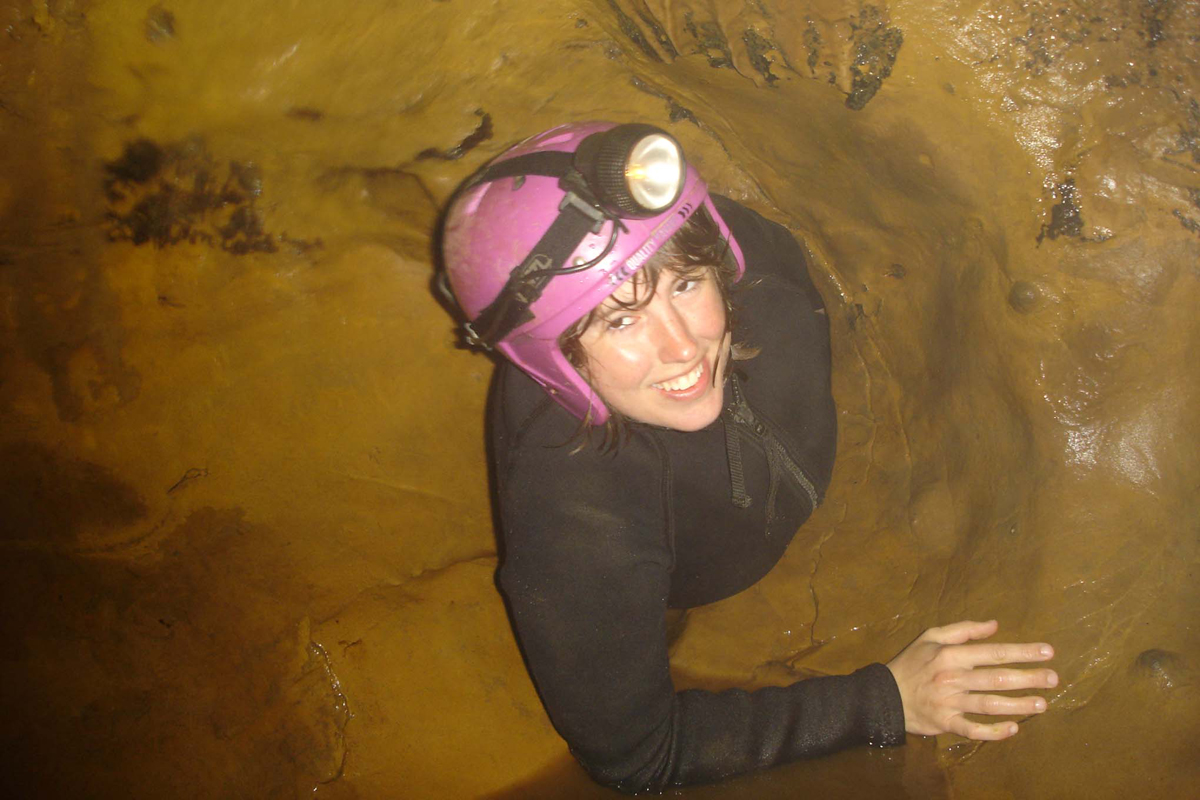
Exiting through the Rebirthing Hole
It was still sprinkling outside as we walked to our final adventure, a hydroslide down slippery rock into a cold pool, riding on a little piece of foam rubber. The Danger Girls and Jorgen and I took the plunge. This was easily the riskiest part of the trip, and I don't blame the others for opting out, as any sensible person would have done. But it sure was fun!

Bush walk outside Taniwha Cave
Exhausted, we hiked back half an hour and met up with the truck, which took us back to Wild West headquarters in Greymouth. There we hosed off, stripped off the wetsuits, and climbed into a lovely warm Jacuzzi, where Kevin brought us each a beer and a muffin. That being a strange combo, I gave away the muffin. A TV above the Jacuzzi displayed the photos Kevin had taken during the trip, now available for purchase on CD. NZ$40 seemed steep, but as Wild West knew, we had no photos of our own. We took hot showers, changed, and bought a CD. I absolutely loved the caving trip. I thought there would be more tubing and less hiking, climbing, and crawling, but I loved it.
2:00 p.m. We left Wild West Adventures and headed for Arthur's Pass along the main highway connecting the west coast with the east across the Southern Alps. We weren't going all the way to Christchurch and would turn around at the top.

Along the road to Arthur's Pass
It wasn't raining as we left, but the weather was still sketchy. As the road climbed in altitude, it turned windy and very cold. Every time we stopped the car, we put on more clothes, until finally we ran out of layers. The scenery was fantastic, even with the clouds, and eventually we emerged above them for some spectacular views, of course stopping at every pull-out along the way.
At Otira Viaduct, a/k/a Death's Corner, we pulled off to examine this engineering marvel. Completed as recently as 1998, the viaduct was built to bypass a section of road that had been repeatedly covered by landslides. Over another section of the road a cover has been built to let the landslides pass safely across.
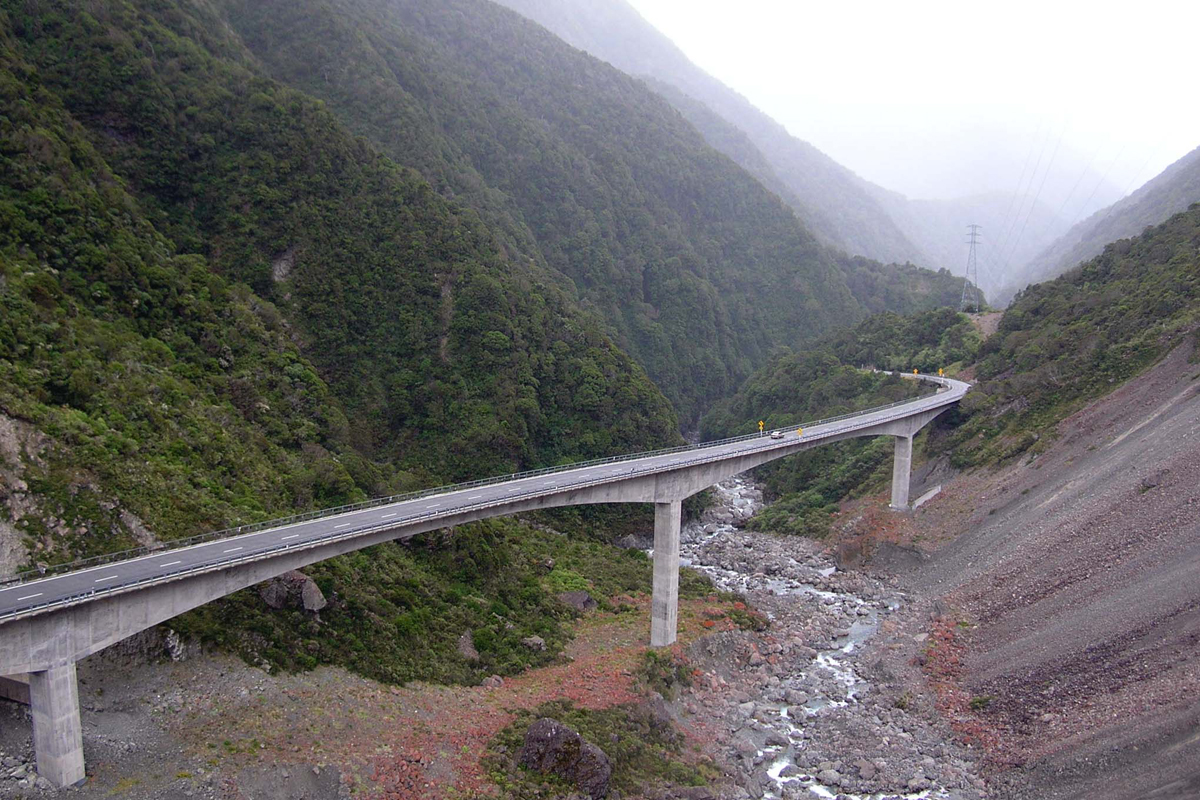
Otira Viaduct
The town of Arthur's Pass, at 924 meters (3,032 feet) above sea level, is New Zealand's highest-altitude town. Here you'll find Devil's Punch Bowl, a fantastic 131-meter (430-foot) waterfall. We turned around here and drove back out of the mountains to the town of Hokitika.

Devil's Punch Bowl
On our way down we crossed over a one-lane bridge meant for two-way vehicle traffic and also trains. At least we weren't riding a bike over it! New Zealand is infamous for its many one-lane bridges with their mildly helpful pictograms indicating who must "give way" (yield) to whom. We only saw a few that were also used by trains.
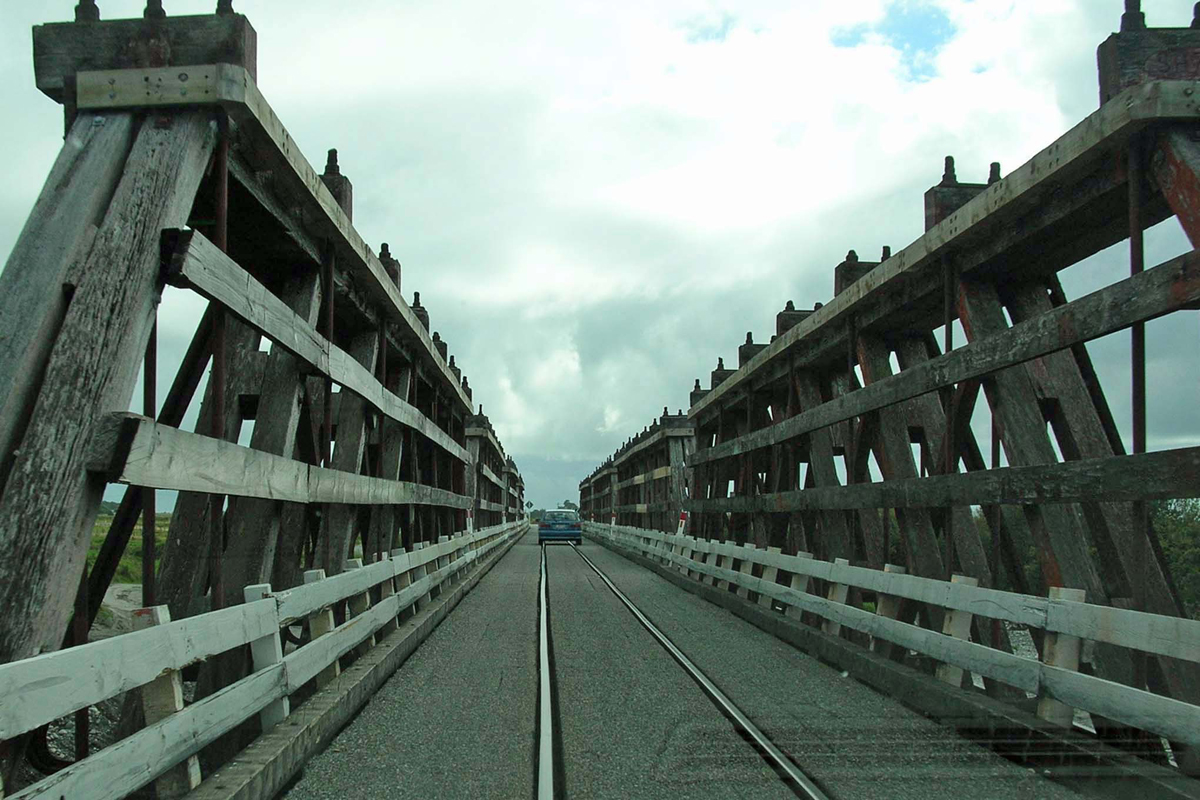
This is nuts

Cuidado!
5:30 It was getting late in the day, and we were only in Hokitika. I had to call our lodgings in Okarito again to make sure we still had a room. Phoning was again an ordeal, but we finally accomplished it at the third or fourth pay phone we tried. Cindy at Kotuku Lodge was glad I called, and yes, they were holding the room for us. We were about one and a half hours away still, and we'd yet to go shopping.
Okarito is a tiny town with only 37 residents and no restaurants or grocery stores, so we had to bring our own food. Hokitika is the last town for groceries. We picked up ingredients for spaghetti and meat sauce for tonight and sandwiches for lunch tomorrow. We were all set. At first we were making good time, but then it started raining. It kept raining harder and harder, until I could barely see past the windshield wipers.
7:30 Hooray! We made it. I was just glad to finally stop driving. It had been a really long day. We followed the directions I'd been given to the lodge: "When you come into Okarito, our office is the 2nd house on the right." Easy enough. Just as I parked, the rain stopped. The town has its own little microclimate. We went inside and met our hosts, Cindy and Rainer, who took our money (NZ$60), pointed to the lodge two houses down, and kept making smalltalk. Turns out Cindy is an American, but she's been in Okarito a long time. Finally I asked for our room key so we could settle in, and they seemed a bit surprised. "Oh, we don't have keys in Okarito. Just go on in, and your room is the only double." Well, okay.
Tom and I were hesitant to go inside the house and start opening bedroom doors willy nilly -- there was an Australian couple and three Israeli girls staying there also -- but we found the room with no problem. This place is great. The bathroom is shared, but with so few people it works out fine. There's a huge living room and kitchen, and the kitchen is stocked with everything necessary (except food) for cooking a fine meal.
A huge lawn out back leads to the seashore, where we saw a pretty little mini-sunset beneath the low-hanging clouds. The bush surrounding Okarito is prime kiwi habitat, but they're very rare, and the chances of actually spotting one of these nocturnal, flightless birds is almost nil.

Sun sets beneath the clouds, Okarito
Back at the lodge, we fixed our spaghetti and enjoyed a nice, home-cooked meal. All the hostels where we stayed have shared kitchens, but this is the only place we used anything other than the kettle for preparing our morning coffee. I questioned the cleanliness of the dishes at a lot of the places, but these were spotless.
After cleaning up from supper, we went out and looked at the stars. The clouds had disappeared, and more stars were visible than either Tom or I had ever seen in our lives, billions and billions. It was amazing. Okarito is wonderfully secluded, and we wished we had another night here.